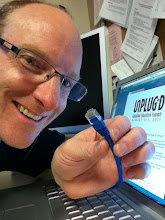Like many others, I have frequently dragged the little yellow dude onto a map in Google Streetview, but I hadn't done so through my 'little kid' eyes. What I discovered took me on an emotional ride that is sure to continue. Let me just share a few highlights from earlier this evening.
 A virtual visit to what will always be for me, the home of my granparents, sent me to reconsider a tree that was gnarled and gigantic in my youth; to reminisce about playing with the large-grated air vents in the upstairs bedroom; to reflect on my grandfather's habit of listened to Tiger games on the radio, while simultaneously watching a game or two on television.
A virtual visit to what will always be for me, the home of my granparents, sent me to reconsider a tree that was gnarled and gigantic in my youth; to reminisce about playing with the large-grated air vents in the upstairs bedroom; to reflect on my grandfather's habit of listened to Tiger games on the radio, while simultaneously watching a game or two on television.And that thought sent me to Tiger Stadium. Though it no longer stands, the glow of the stadium at nighttime was a common spectacle from downtown Windsor... so Google Streetview beckoned.
 Most images in Google's cache still show the home plate quarter of the stadium, but this one photo was taken another day, after the camera car had completed the Michigan-Trumbell-Cochrane loop. This image captured the fall of the Ernie Harwell's booth and the best seats in the house, while a proud flag waved from the centre field flag pole!
Most images in Google's cache still show the home plate quarter of the stadium, but this one photo was taken another day, after the camera car had completed the Michigan-Trumbell-Cochrane loop. This image captured the fall of the Ernie Harwell's booth and the best seats in the house, while a proud flag waved from the centre field flag pole!  My inner conversation let me next to consider the two most significant sports fields of my youth. The first was the street in front of my house that was home to road hockey, street football, and kick the can.
My inner conversation let me next to consider the two most significant sports fields of my youth. The first was the street in front of my house that was home to road hockey, street football, and kick the can. The other, was the school down the road where I learned to run track, play basketball, and work on my short game on our custom par three golf course". The most surprising memory trigger for me, was the pole that now sits outside of the school playground. It marks the spot where we played tag games like British bulldog, and where hero pranksters opened the fire hydrant to flood our schoolyard for winter skating. It's also where the Duncan Yo-Yo man wowed us with tricks and hooked us on what was to us, a brand new toy.
The other, was the school down the road where I learned to run track, play basketball, and work on my short game on our custom par three golf course". The most surprising memory trigger for me, was the pole that now sits outside of the school playground. It marks the spot where we played tag games like British bulldog, and where hero pranksters opened the fire hydrant to flood our schoolyard for winter skating. It's also where the Duncan Yo-Yo man wowed us with tricks and hooked us on what was to us, a brand new toy.The details of my memories may be of little interest to others (including my own children), but to me, the memories are priceless. And the detail and pace at which they came flooding back was surprising when inspired by modern day digital images.
But I'm late to the party!
Shortly after My Childhood Community appeared, Stephen Downes contributed Where I Grew Up, a reflective post very similar in flavour to Doug's post.
A few days after that, Megan Palevich posted A Walk Down Memory Lane with Google Streetview. After embracing personal memories with her mother, Megan took the idea a step further, considering how students and teachers might embrace this idea.
The lesson she developed was later shared with Zoe Branigan-Pipe whose reflection highlights what for me was the biggest story in the experience... the great value we can discover in sharing our ideas with other networked teacher-learners.

 Doug Peterson started more than a meme. He set memories in motion; initiated creative storytelling; inspired collaborative networking. Now that he's posted An Idea that Keeps Growing, you can take your digital time travel to new levels.
Doug Peterson started more than a meme. He set memories in motion; initiated creative storytelling; inspired collaborative networking. Now that he's posted An Idea that Keeps Growing, you can take your digital time travel to new levels. As a first step, reward yourself with an augmented trip through your own memories.






